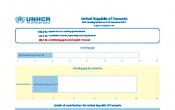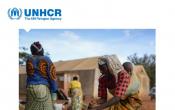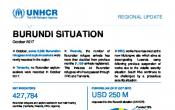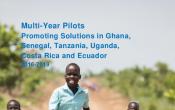United Republic of Tanzania
Operation: United Republic of Tanzania
Location
{"longitude":35,"latitude":-6,"zoom_level":0}
Latest update of camps and office locations 21 Nov 2016. By clicking on the icons on the map, additional information is displayed.
Key Figures
| 2018 planning figures | |
| 100% | of Congolese refugees identified in need of resettlement will have their cases submitted for resettlement |
| 85% | of primary school-aged Burundian refugee children will be enrolled in primary school |
| 75% | of Congolese refugees (18-59 years) with own business/self-employment for more than 12 months |
| 60% | of Burundian refugee households will be living in adequate dwellings |
| 1,160 | Congolese refugees per each hygiene promoter |
| 26 | liters of potable water will be available per person per day |
| 0.5 | Crude mortality rate (per 1,000 population/month) for Burundian refugees |
| 2016 end-year results | |
| 198,000 | individuals (including 3,500 new-born children) registered using UNHCR’s ProGres database |
| 41,100 | Burundian refugee children and 37,380 Congolese refugee children were enrolled in primary education |
| 3,200 | sexual and gender-based violence (SGBV) incidents were reported among Burundian and Congolese community |
| 11,100 | transitional shelters were constructed with coverage of 28 per cent across the three camps |
| 9% | of the Burundian and Congolese refugee populations in Nyarugusu camp received liquefied petroleum gas (LPG) as part of a pilot |
More Information
People of Concern
20%
Increase in
2016
2016
| 2016 | 458,828 |
| 2015 | 382,620 |
| 2014 | 252,357 |

[["Refugees",281498],["Asylum-seekers",8539],["Returned refugees",6],["Others of concern",168785]]
Loading ...
United Republic of Tanzania
< Back
2016
{"categories":[2013,2014,2015,2016,2017,2018],"budget":[39.65703876,38.21491383,134.15516444,108.50987822,137.1331802,125.929220281],"expenditure":[19.39590816,24.6811937,48.87004149,69.99019142,null,null]}
{"categories":[2013,2014,2015,2016,2017,2018],"p1":[15.86371529,23.19500923,118.73635308,96.04563581,126.70166642,122.709283001],"p2":[null,null,null,null,null,null],"p3":[23.79332347,15.0199046,15.41881136,12.46424241,10.43151378,3.21993728],"p4":[null,null,null,null,null,null]}
{"categories":[2013,2014,2015,2016,2017,2018],"p1":[13.24639973,20.0803866,42.24403878,65.51548653,null,null],"p2":[null,null,null,null,null,null],"p3":[6.14950843,4.6008071,6.62600271,4.47470489,null,null],"p4":[null,null,null,null,null,null]}
Loading ...
CHOOSE A YEAR
- 2014
- 2015
- 2016
- 2017
- 2018
Year-end Overview
Plan Overview
Working environment
The United Republic of Tanzania continues to host large numbers of refugees. In 2017, the total population of concern stood at some 743,000 people.
In the Tripartite Commission Meeting held in August 2017, the Governments of Burundi and Tanzania committed to the principles of voluntary repatriation of refugees in safety and dignity. In the first two months of the voluntary repatriation, close to 6,900 people have returned to Burundi from the United Republic of Tanzania.
UNHCR works with the Government of Tanzania and other partners for the provision of protection and basic services to refugees and other people of concern, and will continue supporting the Government in the process of rolling out the Comprehensive Refugee Response Framework (CRRF) in 2018.
UNHCR’s multi-year protection and solutions strategy is guided by five core directions, which through UNHCR’s leadership under the Refugee Coordination Model (RCM), will advance protection and solutions for all people of concern in the United Republic of Tanzania. The core directions are: to protect, respond, include, empower and find solutions. UNHCR continues to support the Government in the review of the national legal framework related to refugees aiming at adherence to international standards and for the gradual refugee’ access to national systems. In addition, UNHCR puts emphasis on self-reliance to minimize long-term dependency on humanitarian assistance, ensure adequate emergency response, strengthen the engagement and participation of refugee communities at all levels, and promote peaceful coexistence between refugees and host communities. Alternatives to camps policy is being reviewed with the Government of Tanzania and initiatives towards moving away from a strict encampment policy revisited.
Key priorities
UNHCR’s key priorities are :
- Ensuring continuous access to territory, reviewing of the 1998 Refugee Act, and the 2003 Refugee Policy, provision of refugee documentation, mitigation of risks of SGBV, and legal aid.
- Seeking durable solutions. UNHCR will work with the Government of Tanzania to support and facilitate solutions for the remaining Burundian refugees who arrived in 1972 and their naturalization. The Office will also submit resettlement cases and support the voluntary repatriation of Burundian refugees in safety and dignity.
- Providing essential preventive and curative health care services and maintaining and availing water systems at minimal level to refugees and asylum-seekers. Further, UNHCR puts emphasis on increasing the latrine coverage in the camps.
- Moving gradually from emergency to transitional shelters, resistant of heavy rains and that will help to mitigate protection risks faced by women.
- Providing formal education with particular attention to primary and secondary education. UNHCR will advocate for the inclusion of refugee children into the national education system. However a shift from the country of origin to the country of residence curriculum will be a pre-condition.
- Supporting the empowerment of refugees through entrepreneurship skills and vocational trainings, as well as access to common markets and the identification of cash-based interventions opportunities.





